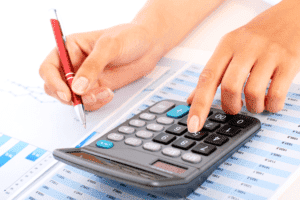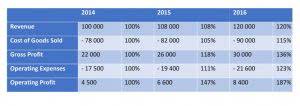
Once you calculate your cost of goods sold (COGS), you can use your cost to calculate your price. Margin percentage grows slower than markup because it’s calculated on larger revenue base. As markup increases, the denominator in margin calculation (revenue) increases faster than numerator (profit), causing percentage growth rate differences. You can also figure the margin vs markup gross margin for your small business by using total revenue and costs of goods sold instead of single item numbers.
How do I calculate markup?
Margin and markup are different metrics that serve different purposes. Margin is calculated as a percentage of the selling price and tells you what portion of your revenue is profit. Markup is calculated as a percentage of the cost and tells you how much you’ve increased the price above your cost. Notice that when you enter the cost in both of these examples and the desired margin or markup, the selling price is going to be different.
Margin calculation example (how to calculate margin)
Keep reading to learn more about what is margin, margin vs markup, how to calculate them, and how to convert numbers between the two. With a clean interface, responsive layout, and accurate results, this calculator saves time and boosts pricing confidence. Our Margin and Markup Calculator is more than just a tool — it’s a business asset. Whether you’re launching a new product or managing a catalog of hundreds, having a clear view of your profits can make all the difference.
Margin Markup Calculator and Converter

If your numbers are flawed in any way, you can cause a backlog of work for your fulfillment team or end up with piles of How to Run Payroll for Restaurants dead stock or cycle stock in the warehouse. Conversely, if you think your goal markup should be the margin, you can accidentally be pricing your products too high. This is very off-putting to customers and can damage your relationships as well as drive down demand for the products. Even worse, this can cause a bullwhip effect that will upset the supply and demand balance throughout your entire supply chain. Though commonly mistaken for one another, markup and margin are very different.
Maintaining proper margin ensures business sustainability, while markup focuses on cost recovery. The Margin Markup Calculator is a versatile tool that allows you to calculate the margin, markup, revenue, and profit of a product or service based on different input parameters. Whether you are setting prices, evaluating costs, or determining profitability, this calculator can help you make informed decisions. Understanding margin is crucial for investors and businesses because it directly impacts profitability and financial stability. For investors, online bookkeeping margin trading can enhance returns but also increases risk, so knowing how it works helps in making informed decisions. For businesses, maintaining healthy profit margins ensures they cover their costs and generate profits, which is essential for growth and sustainability.
- The profit shown in the results represents your gross profit before considering operating expenses, taxes, and other costs.
- This means that margin tells you how much of the selling price is profit after covering the cost.
- Armed with the ability to calculate profit margins, businesses can better evaluate performance and ensure long-term financial health.
- As an example; the item costs $5.00 and is selling for $10,00.
- The cost of manufacturing the Zealot may not always stay at $18 (actually, it definitely won’t).

Calculate the margin by subtracting the cost of goods sold (COGS or cost price) from the selling price and dividing that number by the selling price. Aiming for a certain margin, but need to know what your markup should be? Besides giving you the markup percentage, it also helps you decide on the retail price of a product. For instance, say you sell a large pizza that costs $5 to make. The markup percentage calculation is (cost X markup percentage), added to the original unit cost to arrive at the sales price. Calculating margin requires only two data points, the cost of the product and the price it’s being sold at.
- Typically, markup is expressed as a percentage of the cost of a product.
- This, in turn, enables them to maximize revenue, remain competitive in the market, and ultimately grow their business sustainably.
- Let’s say the cost for one of Archon Optical’s products, Zealot sunglasses, is $18.
- For example, if you buy a product for $50 and want to apply a 30% markup, the markup will be $15.
- However, since they are calculated differently and have different purposes, there are more differences than similarities when comparing markup vs margin.
- It’s calculated by subtracting the cost of the product from its selling price, then dividing that by the selling price.
Markup helps businesses determine the price at which they need to sell products to cover their costs and generate profit. By setting an appropriate markup percentage, companies can ensure they meet their profit targets while factoring in production costs, overheads, and desired margins. Understanding both markup and margin is essential because they help businesses approach pricing from two different perspectives. Markup helps you determine the selling price based on costs, while margin helps you understand how much of your revenue is actual profit. Both calculations are important for businesses to ensure they are pricing their products correctly and maximizing profitability.
If you are calculating the markup, the selling price will be lower. No, markup and margin use different formulas and are typically not the same percentage, even if the cost and selling price are similar. Higher margins require careful balance between costs and market prices. Margin-based pricing ensures profitability targets are met regardless of cost fluctuations.
You can also use a markup vs margin table to easily see this relationship for the most common rates. Gross profit is the difference between the selling price and the cost price of a product. Quickly calculate your margin or markup and understand the key differences to price your products correctly. The advanced calculator is highly customizable, allowing users to tailor it to their specific needs. Businesses can modify the calculator to include additional fields, such as tax rates, shipping costs, or overhead expenses, giving a more comprehensive view of profitability. Users can also set default values for certain fields, streamlining the calculation process for frequently used pricing scenarios.

Example 4: Calculating Profit Margin Percentage from Cost Price and Selling Price

While both markup and margin are critical for determining pricing and profitability, they have distinct differences in their calculations and what they represent. Understanding these differences is essential for any business owner or manager to set the right pricing strategies and ensure profitability. Use this calculator to verify actual profit percentages before setting prices.
